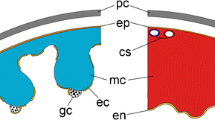Summary
The innervation of the aesthetasc hairs ofParagrapsus gaimardii differs slightly from that of other decapods described. Each outer flagellum bears from 160 to 170 aesthetascs each of which is innervated by approximately 130 bipolar sensory neurons. Distally the dendrite from each neuron bears two cilia at a ciliary junction. Each ciliary junction lies within an extracellular space and is situated below the base of the aesthetascs. The cilia have a 9+0 structure in their basal region. Just distally this structure becomes disorganized, the A- and B-subfibres separate and the dendrites increase in diameter. There is evidence for the branching of the cilia resulting in approximately 500 sensory endings per aesthetasc.
No cellular processes are present in the distal 3/4 of the aesthetasc lumen. No pores were found in the aesthetasc walls which are “spongy” in appearance and permeable to crystal violet along the distal 3/4 of their length. The environmental significance of the “spongy” wall and the possible function of the cilia in early transmission of stimulus energy are discussed.
Similar content being viewed by others
References
Ghiradella, H. T., Case, J., Cronshaw, J.: Structure of aesthetascs in selected marine and terrestrial decapods: Chemoreceptor morphology and environment. Amer. Zool.8, 603–621 (1968b).
Ghiradella, H. T., Case, J., Cronshaw, J.: Fine structure of the aesthetasc hairs ofCoenobita compressus Edwards. J. Morph.124, 361–385 (1968a).
Ghiradella, H. T., Cronshaw, J., Case, J.: Fine structure of the aesthetasc hairs ofPagurus hirsutiusculus. Protoplasma61, 1–20 (1968).
Gibbons, I. R., Grimstone, A. V.: On flagellar structure in certain flagellates. J. biophys. biochem. Cytol.7, 697–716 (1960).
Graziadei, P. P. C., Tucker, D.: Vomeronasal receptors in turtles. Z. Zellforsch.105, 498–514 (1970).
Humanson, G. L.: Animal tissue techniques. San Francisco and London: Freeman & Co. 1962.
Krijgsman, B. J., Krijgsman, N. E.: Osmorezeption inJasus lalandii. Z. vergl. Physiol.37, 78–81 (1954).
Laverack, M. S.: The antennular sense organs ofPanulirus argus. Comp. Biochem. Physiol.13, 301–321 (1964).
Laverack, M. S.: On the receptors of marine invertebrates. Oceanogr. Mar. Biol. Ann. Rev.6, 249–324 (1968).
Laverack, M. S., Ardill, D. J.: The innervation of the aesthetasc hairs ofPanulirus argus. Quart. J. micr. Sci.106, 44–60 (1965).
Lin, H. S., Chen, I.: Development of the ciliary complex and microtubules in the cells of the rat subcommisural organ. Z. Zellforsch.96, 186–205 (1969).
Miller, I. J.: Peripheral interactions among single papilla inputs to gustatory nerve fibres. J. gen. Physiol.57, 1–25 (1971).
Morita, H.: Generator potential of insect chemoreceptors. Proc. 16th Intern. Congr. Zool.3, 105–106 (1963).
Morita, H.: Receptor potential recorded from sensilla basiconica on the antenna of the silkworm larvae,Bombyx mori. J. exp. Biol.38, 851–861 (1961).
Morita, H., Yamashita, S.: The backfiring of impulses in a labellar chemosensory hair of the fly. Mem. Fac. Sci. Kyushu Univ. (E) (Biol.)3, 81–87 (1959).
Nielsen, S.-O., Strömberg, J.-O.: Surface structure of aesthetascs in Cryptoniscinae (Isopoda Epicaridea). Sarsia (in press) (1973).
Reese, M. D.: Olfactory cilia in the frog. J. Cell Biol.25, 209–230 (1965).
Slifer, E. H.: A rapid and sensitive method for identifying permeable areas in the body wall of insects. Ent. News71, 179–182 (1960).
Slifer, E. H.: The structure of arthropod chemoreceptors. Ann. Rev. Ent.15, 121–142 (1970).
Slifer, E. H.: Some evidence for the continuity of ciliary fibrils and microtubules in the insect sensory dendrite. J. Cell Sci.4, 527–540 (1969).
Slifer, E. H., Sekhon, S. S.: The thin-walled olfactory pegs of the grasshopper. J. Morph.114, 393–410 (1964).
Snow, P. J.: The antennular activities of the hermit crab,Pagurus alaskensis. (In preparation.)
Tucker, D.: Olfactory cilia are not required for receptor function. Fed. Proc.26, 544 (1967).
Weel, P. B., van, Christofferson, J. P.: Electrophysiological studies on perception in the antennulae of certain crabs. Physiol. Zool.39, 317–325 (1966).
Wolbarsht, M. L.: Electrical signs of chemoreception. Proc. 16th Intern. Congr. Zool.3, 107–110 (1963).
Wolbarsht, M. L., Hanson, F.: Electrical activity in the chemoreceptors of the blowfly: III. Dendritic action potentials. J. gen. Physiol.48, 673–683 (1965).
Yamada, M.: The dendritic action potentials in an olfactory hair of the fruit piercing moth,Oraesia excavata. J. Insect. Physiol.17, 169–179 (1971).
Zacharuk, R. Y.: Fine structure of peripheral terminations in the porous sensillar cone of larvae ofCtenicer destructor (Brown) (Coleoptera, Elateridae) and probable fixation artifacts. Canad. J. Zool.49, 789–799 (1971).
Zacharuk, R. Y., Yin, L. R.-S., Blue, S. G.: Fine structure of the antenna and its sensory cone in larvae ofAedes aegypti (L.). J. Morph.135, 273–298 (1971).
Author information
Authors and Affiliations
Additional information
The author is indebted to Prof. B. Johnson and Dr. I. S. Wilson for much helpful discussion and reading the early manuscript and to Prof. D. M. Ross, Dr. K. G. Pearson and Dr. J. C. Tu for reading the final manuscript.
Rights and permissions
About this article
Cite this article
Snow, P.J. Ultrastructure of the aesthetasc hairs of the littoral decapod,Paragrapsus gaimardii . Z.Zellforsch 138, 489–502 (1973). https://doi.org/10.1007/BF00572292
Received:
Issue Date:
DOI: https://doi.org/10.1007/BF00572292




